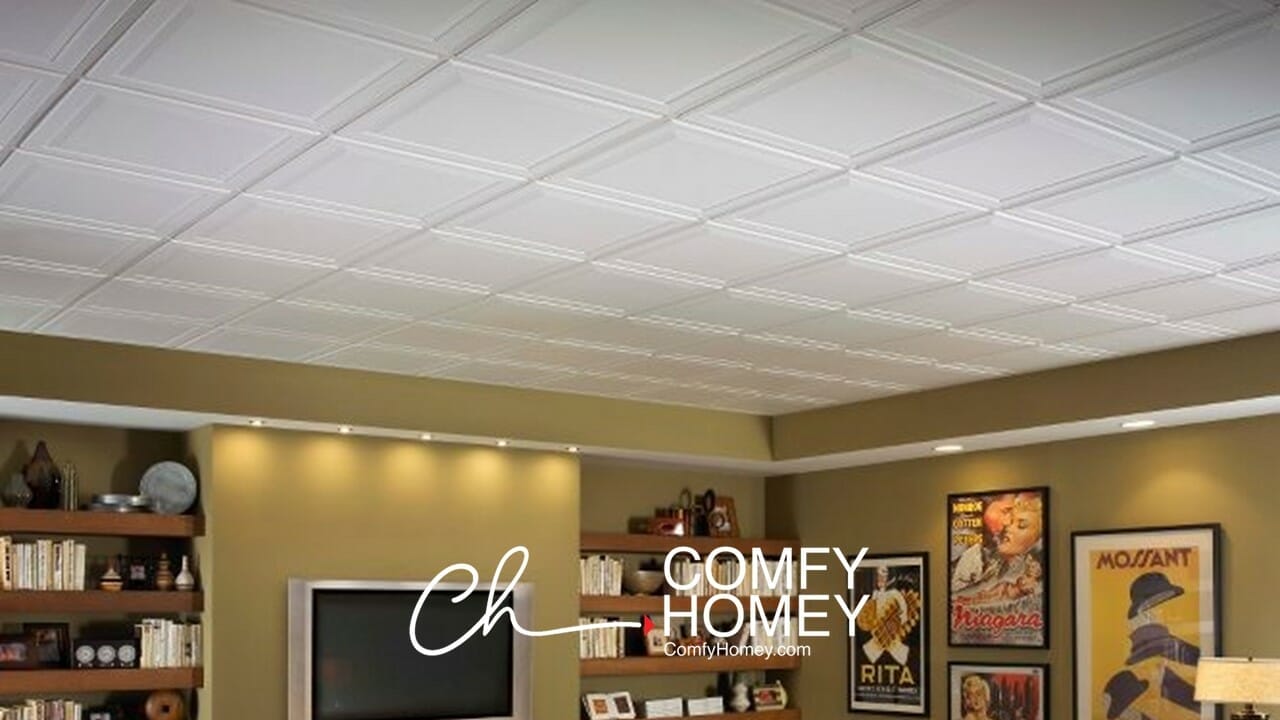Table of Contents
ToggleDiscover the best and simplest ways to soundproof the ceiling! Reduce the noise levels in your home with these cost-effective and easy-to-implement techniques.
Noise from upstairs neighbors or other parts of the home can cause all sorts of distractions and interruptions. Fortunately, there are simple ways to soundproof the ceiling in order to reduce the noise and create a peaceful space. In this article, we will explore some cool ideas on how to effectively soundproof the ceiling without breaking the bank. From creative DIY solutions to affordable soundproofing materials, we have you covered!
Soundproof The Ceiling: Benefits Of Soundproofing
First and foremost, soundproofing the ceiling means eliminating unwanted noises from outside or other rooms, allowing for increased peace and quiet. This can be especially helpful if you live in a loud neighborhood or work from home often. Additionally, soundproofing can block out bass frequencies which tend to travel through walls more easily than higher ones. This makes it harder for neighbors to complain about your late-night jam sessions.
Furthermore, soundproofing has health benefits that make it worth considering even beyond just providing peace and quiet. It helps minimize stress levels which are often heightened by excessive noise pollution, resulting in improved mental health conditions like insomnia or anxiety.

Soundproof The Ceiling: Materials And Tools Needed
Soundproofing the ceiling is a great way to reduce unwanted noise in any home. Not only will it keep sounds from entering your living space, but it can also help block out loud noises coming from the outside world. This article will provide an overview of the materials and tools needed to soundproof the ceiling.
When soundproofing a ceiling, materials such as acoustic foam panels, insulation, and drywall are essential components. Acoustic foam panels are designed to absorb noise and vibrations from entering through walls or ceilings. Insulation is great for blocking sound due to its dense material that does not allow soundwaves to pass through easily. Finally, drywall provides yet another barrier against both airborne and structural noises by providing additional mass between wall studs and floor joists.
In addition, you’ll need adhesives such as spray adhesive or latex caulk so that your materials can be securely attached to the walls or ceiling surface. You should also invest in a good quality sealant for air leaks around windows and door frames where sound could travel through easily. Finally, make sure you have enough screws and nails on hand for installation purposes.
Soundproof The Ceiling: Cost Considerations
Soundproofing is an effective way to reduce noise from the outside or other rooms and can be an important part of creating a peaceful environment. But before taking on this project, it’s important to understand the cost considerations that come with soundproofing a ceiling.
The first factor to consider when planning how much it will cost to soundproof your ceiling is the type of materials you choose. There are different types of insulation that can be used in ceilings, such as fiberglass, rock wool, or foam boards, which vary widely in price and performance. To determine what type is best for your needs, speak with a local contractor who specializes in this type of work.
Other costs associated with soundproofing a ceiling include materials like drywall or plasterboard and possibly additional labor costs if professional installation is required.
Soundproof The Ceiling: Preparing The Room
Whether you’re outfitting your home music studio or creating a dedicated space within your business, soundproofing the ceiling will help create the perfect environment for recording audio.
To soundproof the ceiling, it begins by addressing any ventilation issues that could cause reverberation and other unwanted noise. Removing existing air vents can help contain sound within the room while adding insulation between drywall and studs will dampen airborne noise from outside sources. Additionally, installing acoustic tiles or panels to the ceiling can further reduce reverberation and echo inside the room.
It can ensure that outside noises don’t interfere with your recording and that your music won’t disturb the neighbors. Preparing the room for soundproofing the ceiling involves more than just laying down some insulation; you need to be aware of potential structural issues, air leaks, and other factors before beginning the process.
Before getting started, it’s important to make sure that your ceiling joists are in good condition. Check for any cracks or gaps between joists and repair as needed with caulk or construction adhesive. Make sure all light fixtures are properly grounded and sealed off from potential air leaks. Also, inspect walls, windows, and doors to identify any points where noise could potentially travel through.
Soundproof The Ceiling: Measure And Cut the Ceiling
The sound of an upstairs neighbor playing their music too loud or a downstairs neighbor having a rowdy party can be very distracting and make it difficult to relax at home. Soundproofing the ceiling can help reduce noise from outside sources, giving you peace and quiet in your own home. To soundproof the ceiling, start by measuring and cutting it properly.
Before beginning any project, measure twice to ensure accuracy. Measure across the width of the room as well as lengthwise to get accurate measurements for cutting drywall. Mark off any measurements with a pencil on each panel before cutting them out with a utility knife or saw. When cutting through drywall, use caution and wear protective eyewear if needed. Once all panels are appropriately measured, marked off, and cut out, they are ready to install.
Soundproof The Ceiling: Installing Mass Loaded Vinyl
Installing mass-loaded vinyl is an effective and economical way to soundproof the ceiling in a home or office. Mass-loaded vinyl, also known as MLV, is a flexible material made of PVC vinyl with added fillers like limestone and diatomaceous earth that increase its weight and density. It works as an absorber of sound waves, blocking out background noise from other rooms or outside sources.
MLV is easy to install for anyone with basic DIY skills. The material comes in rolls of various sizes, so you can choose one that’s appropriate for the size of your room. It’s important to measure both the length and width of your ceiling before cutting the panel. To apply it, you can either staple it directly onto wood joists or suspend it from metal hangers attached to wooden rafters or studs underneath your floorboards/ceiling slab.
Soundproof The Ceiling: Building A Suspended Ceiling
Building a suspended ceiling is one of the most effective ways to soundproof the ceiling. A suspended ceiling is created by placing acoustic tiles or panels between two parallel grids of metal tracks, suspending them from the original ceiling. Suspended ceilings are relatively easy to install and are available in numerous styles and materials that can suit any decor.
Suspended ceilings provide excellent sound insulation due to their construction which consists of two sheets of material that act as a barrier between the living space and the outside environment. Additionally, they effectively absorb noise from within a room, making it easier for occupants to converse without having to raise their voices over disruptive noises coming from outside sources such as neighbors or traffic. Furthermore, they can also help reduce reverberation time within a room, reducing echoes and providing better clarity for spoken dialogue.
Soundproof The Ceiling: Sealing Gaps And Cracks
To soundproof the ceiling, sealing gaps and cracks is an essential step. Sealing up these spots in your ceilings can help reduce the amount of sound that passes through, creating a more peaceful environment in your home or office. Gaps and cracks are usually found around light fixtures, joint lines between walls and ceilings, behind baseboards, and along other edges.
Fortunately, there are several methods you can use to seal these gaps and cracks. Acoustic caulk is one option for filling small holes, which provides an effective seal without having to replace any drywall. Additionally, acoustic sealant tape may be used for larger areas, such as those around lighting fixtures or baseboards where caulking guns would not fit comfortably inside.
Soundproof The Ceiling: Adding Wall Insulation
Having a noisy household can be more than just an annoyance; it can interrupt focus, concentration, and even sleep. Fortunately, there is something you can do to soundproof the ceiling in your home with wall insulation. Wall insulation is not only effective at keeping out external noise sources such as traffic or barking dogs; it also helps keep sound trapped within one room. This makes it especially useful for creating quiet zones in busy households.
When adding insulation to the walls and ceiling of a room, there are several factors to consider that will determine which type of material and installation method is best for your needs. For instance, fiberglass batts are usually the most cost-effective option, but they may not provide as much soundproofing as other materials like rock wool or polyurethane foam.

Soundproof The Ceiling: DIY Alternatives To Panels/Tiles
If you’re looking for a way to soundproof the ceiling in a cost-effective and efficient manner, then DIY alternatives are the perfect choice. From foam panel tiles to acoustic blankets, there is an abundance of options available when it comes to soundproofing your ceiling without having to buy expensive and bulky panels.
Using foam panel tiles is one of the most popular methods when it comes to DIY soundproofing methods, as they are easily installed on the ceiling and provide effective noise reduction. They come in different sizes and thicknesses so that you can find the right fit for your specific needs. Furthermore, these foam panel tiles also work great with other materials, such as acoustic blankets or egg cartons, which can be used in combination with one another to increase sound absorption capabilities further while keeping costs down.
Final Thoughts: Soundproof The Ceiling To Achieve A Quieter Home
In conclusion, to soundproof the ceiling is a great way to achieve a quieter home. By taking the time to install insulation, reduce air gaps and cover it with sound-absorbing materials, you can make your home more peaceful in no time. It’s an affordable and effective solution that can make your living space more comfortable for both you and your family. If you are looking for a simple way to reduce noise pollution in your home, soundproofing the ceiling is a great place to start.















